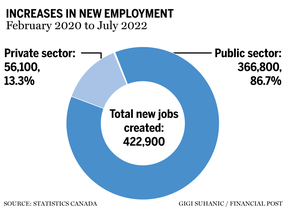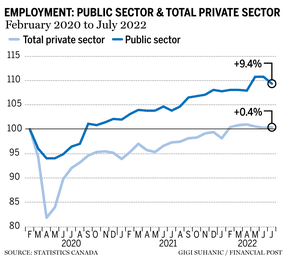Relying on an artificial boost of government-led hiring to prop up the economy is unsustainable
Article content
News that the U.S. economy has contracted over two consecutive quarters has led to growing questions about the state of Canada’s economy. Statistics Canada’s flat-lined GDP numbers last month failed to provide a clear answer. The economy may not have fallen into negative territory, but there are signs that it’s slowing and will enter the third quarter facing considerable headwinds.
Advertisement 2
Article content
A complicating factor here is that the strength of the pandemic recovery was probably overstated by the headline data. Claims that Canada’s economy was roaring back belied some flawed fundamentals. A closer read of the underlying data reveals a heavy amount of public-sector hiring, suggesting Canada was experiencing a G-shaped — or government-centric — recovery.
Canada officially surpassed its pre-pandemic level of total employment in November 2021. As of July 2022, the latest month of available data, total employment reached 19.566 million — 422,900 more total jobs than in February 2020, the month before employment started to decline.
Of these 422,900 net new jobs, 366,800 of them were in the government sector. This means that 86.7 per cent of the total jobs gained since the pandemic have been in the public sector. Just 56,100 net new jobs (13.3 per cent of total hiring) have come in the private sector (see accompanying pie chart).
Advertisement 3
Article content

A key explanation for the dismal private sector job growth is that self-employment is still down 214,400 compared to pre-pandemic levels. When the ongoing shortfall in self-employment is combined with the increase in private sector hires (270,500), the net effect is that total private sector employment has increased by just 0.4 percent — virtually unchanged over the past 29 months. Public sector employment, by contrast, has expanded by 9.4 per cent over the same period (see chart).
Of this recent spike in government hiring, roughly one third is temporary, due to the pandemic and other short-term demands. But even if we back out these temporary hires, the increase in permanent public sector employment is still 6.2 per cent (or 242,090 jobs).
Advertisement 4
Article content

These labour market data put the robustness of Canada’s initial pandemic recovery, and the renewed concerns about an economic slowdown, in a different light. Maybe our recent spell of economic sluggishness is actually a better reflection of the Canadian economy’s core fundamentals — including low business investment, poor innovation, weak productivity growth, and a slow-growing workforce. A short-term burst of deficit-financed government hiring may have temporarily masked these long-run challenges, but it won’t have solved them.
In fact, there’s a strong argument that it risks exacerbating them. The public sector’s hiring spree could be crowding out private sector jobs and standing in the way of a more durable and productive private sector-led recovery. Although unprecedented job vacancies in the labour market — more than one million, according to Statistics Canada — are driven in large part by aging demographics, there’s also reason to think that they’re at least in part a consequence of the public sector disproportionately consuming the scarce labour that is available.
Advertisement 5
Article content
This public-private imbalance in our current labour market partly reflects long-standing wage and total compensation differentials between business and government. Research consistently finds that based on apples-to-apples analysis, public-sector workers in Canada receive higher wages, on average, than their private-sector counterparts. The public sector pay premium is even higher after accounting for non-wage forms of compensation, such as pension and health benefits, job security, and typical retirement age.
-

‘Head-scratcher:’ Economists weigh in on Canada’s surprise job loss
-

Canada unexpectedly sheds jobs for second month as labour force shrinks
-

What economists say about Canada’s GDP numbers — and a possible recession
Advertisement 6
Article content
Indeed, a combination of factors — large-scale increases in government spending, ongoing business uncertainty (particularly for the self-employed sector), and considerable wage and benefit differentials — has contributed to the overreliance on governments for post-pandemic hiring. This is not only undermining private sector hiring in the short term, but research tells us that it could even harm the country’s growth prospects over the long term.
Relying on an artificial boost of deficit-financed hiring to prop up the economy is unsustainable as a matter of both economic and fiscal policy, especially in a world of growing government debt and rising interest rates. Growing signs of an economic slowdown should therefore be viewed as a warning about the limits of a G-shaped recovery.
The key takeaway here is that there are no shortcuts to prosperity. Policymakers have no choice but to focus on improving the economy’s core fundamentals. That means increasing the productive capacity of the economy including private sector-led investment, innovation, entrepreneurship and labour force participation. It may not be as easy as a hiring spree, but it’s ultimately the right path to a more robust and sustainable economic recovery.
Charles Lammam is an independent policy analyst and Sean Speer is editor at large at The Hub.
Advertisement
Lammam and Speer: Canada’s ‘G-shaped recovery’ could mask weakness
2022-08-11 19:28:38





